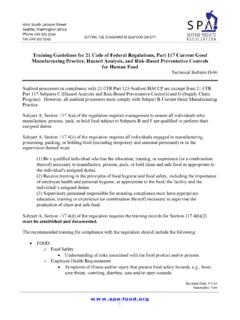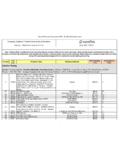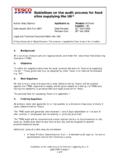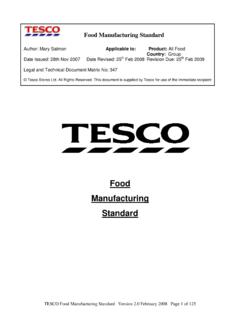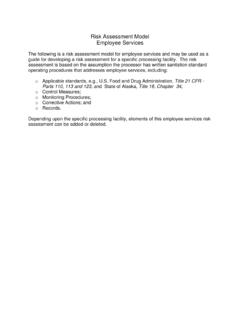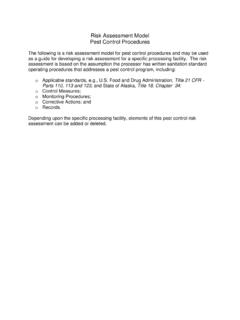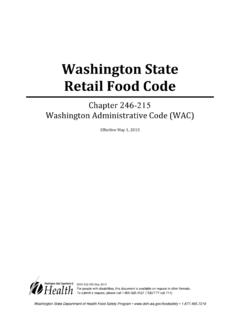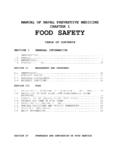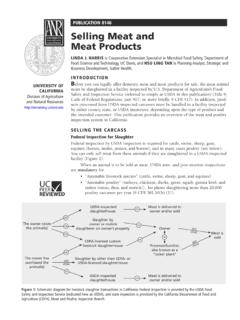Transcription of Risk Assessment Model Foreign Material …
1 Risk Assessment Model Foreign Material Contaminants The following is a risk Assessment Model for Foreign Material contaminants and may be used as a guide for developing a risk Assessment for a specific processing facility. The risk Assessment is based on the assumption the processor has written sanitation standard operating procedures that addresses Foreign Material contaminants, including: o Applicable standards, , Food and Drug Administration, Title 21 CFR - Parts 110, 113 and 123, and State of Alaska, Title 18, Chapter 34;. o Control Measures;. o Monitoring Procedures;. o Corrective Actions; and o Records. Depending upon the specific processing facility, elements of this Foreign Material contaminants risk Assessment can be added or deleted. Risk Assessment Model Foreign Material Contaminants Risk Assessment Potential Hazard Identification: Foreign materials---including metal, glass, wood and other materials---that may be found in the processing environment or that come in with raw materials are potential contaminants of finished the products.
2 Foreign materials in food products constitute filth within the definition of adulteration under the Food, Drug and Cosmetic Act. Risk Assessment Hazard Characterization: The definitions in Title 21, code of federal regulations part 110 Good Manufacturing Practices (GMPs) states: A food is adulterated within the meaning of section 402(a)(3) of the Food, Drug and Cosmetic Act if: (1) it has been manufactured under such conditions that it is unfit for food; or (2) that the food has been prepared, packed, or held under insanitary conditions whereby it may have become contaminated with filth, or whereby it may have been rendered injurious to health. Through the implementation and enforcement of the GMPs, some common Foreign materials can be eliminated from the processing environment and the potential risk of product contamination (adulteration) mitigated.
3 For other potential Foreign contamination, standard operating procedures are necessary to assure operational and maintenance procedures are implemented and performed as scheduled to prevent adulteration of finished products. Risk Assessment Exposure Assessment : All finished food products are potentially exposed to a variety of Foreign Material sources including incoming raw materials, maintenance procedures, equipment, building deficiencies, and employees, including intentional product tampering. Risk Assessment Risk Characterization: The following risk Assessment matrix was used for evaluating the common Foreign materials in the processing environment and the potential for contamination of finished food products. The risk Assessment takes into consideration the potential contaminant, historical data, and accessibility of unprotected product.
4 Risk Assessment Model Foreign Material Contaminants Page No. 2. Severity High Medium Low Frequent - Foreign Material High High Medium normally in processing area Likelihood Possible - Foreign Material not High Medium Low permitted in processing area Unlikely - No history of Foreign Material in processing area but Low Low Low possible Potential Foreign Contaminant Risk SOP Covering Risk*. Buttons from clothing Low Can / end parts High Condensate, flaking paint, dirt Low Contaminated salt Medium Contaminated fish High Deliberate contamination (tampering) High Glass High Machinery / equipment parts Medium Maintenance accessories Medium Magnetic items High Office supply items, , paper clips, thumb Medium tacks, pen clips, etc. Oil and grease Medium Paper Low Personal items, , candy, cigarettes, coins Low Sharp blades High Wood Low All other Foreign Material on any uncovered Medium can conveyors *Enter Company's Standard Operating Procedure Risk Assessment Model Foreign Material Contaminants Page No.
5 3. Risk Management: The relative risk ranges from low to high depending upon the Foreign Material . Implementation and enforcement of the GMPs and/or the established written standard operating procedures should eliminate the potential contaminants from entering finished products. Post processing, the evaluation of customer complaints should also be conducted to determine whether the procedures in place are adequate for preventing finished product contamination, or if there is a need to revise and/or improve existing procedures. Risk Communication: The established written policies must be communicated to all personnel responsible for the receipt of raw materials, processing, shipping, building and equipment repair/maintenance, consumer complaint evaluation, and any other individuals capable of detecting or preventing contaminants from entering the finished products.
